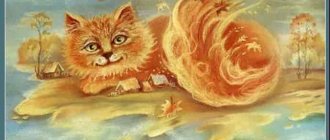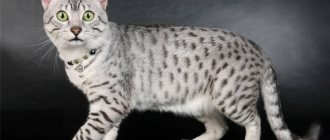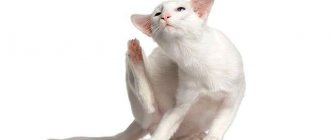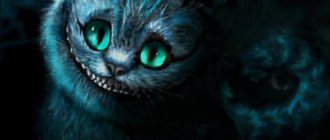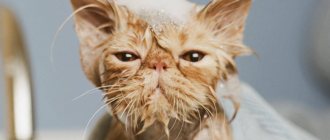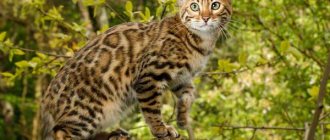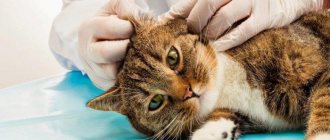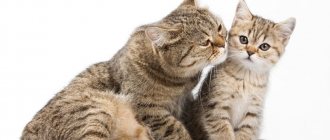There is an opinion that a cat is an animal that God created so that man would have a tiger that he could pet. Even in ancient civilizations, they thought that cats were connected with other worlds. In Egypt, these animals deserved the highest respect; they even had a cat-headed goddess, Bastet. If someone killed a cat in ancient Egypt, he was executed. In other countries, furry creatures have also earned attention in myths and legends. Look in the pictures at how cats were valued in different countries in ancient mythology!
Living without a cat is uncomfortable; it brings a special atmosphere to the house, and it is also believed that the animal lies on a sore spot and can heal it. But it’s not only modern humans who endow cats with magical powers. In the ancient worlds they were generally considered to be higher beings.
Cats in Ancient Egypt
The cat is a solar symbol, meaning royalty. In the mythology of the Egyptians, the cat was believed to be the sun that looked into the underworld at night, because both of them could see in the dark. In this state they were called Mau, which means “seer.”
The cat is a sacred animal of the sun god in Egypt. Legend has it that every night God turns into a red cat and swims across the Nile to illuminate the whole world at dawn.
Bastet - an image of love, anger and beauty
The festivities in honor of Bastet fell on the month that corresponds to our April. At that time, a huge statue of Bastet floated along the Nile on a boat, which was worshiped by people on the banks.
It must be said that the goddess’s easy disposition suggested entertainment that did not correspond to generally accepted moral standards. Sometimes the holiday in honor of Bastet turned into a mass orgy, but this was considered an appeal to the goddess of sensuality and fertility.
The most famous legend about Bastet talks about her anger at people. At the request of the god Ra, whom the peoples of the earth wanted to overthrow, she turned into a lioness and went down to the people, destroying and killing everyone who appeared in her path.
It got to the point that the gods themselves were afraid of Bastet, deciding to calm her down with the help of wine. Mistaking the drink for blood, Bastet began to drink it greedily, became drunk and fell asleep. Waking up, she again turned into an affectionate and gentle cat.
First of all, Bastet was the patroness of women and young girls. They asked her to give them beauty and the ability to charm men, family happiness and youth. It was with the advent of the cult of Bastet that Egyptians began to use their famous makeup, lining their eyes in such a way that they resembled the cat-like gaze of the goddess.
Bastet helped women find love and find happiness in family life
Alas, Bastet could not withstand the Roman invasion of Egyptian lands. After the arrival of the new culture, the deity turned out to be superfluous in the brought beliefs. The decline of the cult of the goddess was also reflected in cats - hostility towards the black representatives of these animals also dates back to the heyday of the Roman Empire. However, images of Bastet clearly tell us that this beauty with a graceful figure and feline profile also had a “golden age”.
Cats of the Ancient East
In the East, cats were credited with remarkable intelligence; they were called the eye of heaven. There, cats were associated with feminine power; they had a secret that they, like women, never revealed.
Because of their round eyes that glow in the dark, they were considered a mysterious animal that actively lives at night. It was believed that a cat could penetrate into other worlds and communicate with the inhabitants of the afterlife, therefore it was able to rid others of negativity.
Login to the site
For cat lovers, I think this information will be very interesting.
Have you ever wondered why we love and cherish our four-legged purring and meowing furbabies so much? Where does such love for predatory animals come from? After all, sometimes gentle psychotherapists are allowed more than a four-legged friend - a dog. And we pamper them more than a devoted and vigilant four-legged watchman. Why did it happen? What did the cat do to deserve our love? Not only because it saves us from rodent pests?!
It's time to remember the role of cats in our society.
Why is a cat called a cat?
The basis of the word “cat” among Europeans is ancient, which is why it sounds so identical in many languages. The word "cat" is closely related to the very important verb denoting birth - kitten, it is also part of the word denoting an animal's cub - catulus (in Latin).
Indeed, we are now saying that “animals give birth.” For our ancestors, such an expression was unacceptable. Only a woman could give birth. The fact is that the word “give birth” is sacred and magical. Among the Slavs, it is associated with the ancient god of the multiplication of the human race - Rod (or Rudra among the ancient Indo-Aryans). A cat, like any livestock, including small ones, can only kitten. Besides cats, kittens include goats, sheep, hares, rabbits, cows and other animals. A pregnant cat was called “sukotnaya” in Old Russian.
There is some connection between the words cat, cattle, lambing (reproduction of domestic animals), perhaps dating back to the beginning of the spread of cattle breeding in Europe, approximately 6-4 millennium BC. At the same time, by the way, the ancient Indo-European languages also took shape. The words “cat” or “cat” when translated from ancient European languages should have meant “giving birth or giving birth.” It indicated a direct connection between the ancient “Murok” and “Vasek” with the cult of fertility.
Proof of this version is the mythological ideas about the cat among the ancient Germans. In the form of a cat, they represented the goddess of love, motherhood, fertility and magic, Freya, the female hypostasis of Odin. There is nothing surprising here. The high reproducibility of offspring in cats is well known. In Europe, these animals were known for a very long time, even before the Roman Empire.
Why is Vaska the cat called Vaska...
In Rus', the most common names of our pets were Murka and Vaska. It’s clear why Murka purrs a lot. But why then is the cat not called Moore (after all, he purrs no worse), Ivan or Peter, namely Vasily? This is where the second mystery of the cat’s name lies for us Russians. But it is connected purely with Slavic mythology. Before the introduction of Christianity in Rus', our ancestors revered the almighty god of the underworld, livestock, wealth and all forest animals - Veles. Veles could take on the images of different animals, the main thing was that the animal was furry - a bear, for example. The cat was a companion of the god Veles, a sacred animal, and many customs and rituals were associated with it.
After the introduction of Christianity in Rus', paganism persisted for a long time. But the name of Veles was prohibited, and the ancient god began to take on the image of St. Blaise or St. Nicholas in the minds of the Russians. Saint Blaise was the patron saint of cattle, as was Belee. It was in honor of St. Blaise in the villages that cats began to be called Vaska - in memory of Veles. Then, of course, the root cause was forgotten. Therefore, when addressing Their Meowing Highnesses, let us remember that in each of them there is a sign of the ancient European goddess of love or the spirit of the great Veles.
A dog is a friend, but a cat is who?
Over thousands of years of living next to humans, the dog has acquired the honorary title of friend. But for some reason, people did not want to elevate the cat to this rank, although it was of considerable use on the farm. There is only one reason for this - the cat was not only loved, but also feared, as it was assumed that it was connected with the magical other world. The cat's mythological involvement in the secret powers of the underworld was known even before the meowing animals fell under the wrath of the medieval church, which accused cats of being associated with witches.
In Rus', the image of a shaggy cat - Veles's companion - was associated with a brownie. Brownies, according to the faith of their ancestors, were of different ranks, and each was responsible for their own plot: some for a house or bathhouse, some for a stable, some for a stable. The Slavs treated all this house brethren with reverent respect and fear. The main brownie was sometimes called the keeper. The brownie kept order, was friendly, but could hasten the death end.
A special mysticism surrounded the construction of new housing. Here sacrifices were certainly needed for the spirit of the new building. Without a ritual offering, the new settlers and their relatives would face death. Whoever crosses the first threshold—the magic line—runs the risk of encountering the mystery of fate. Therefore, the custom was born of letting a cat into the house first, as a beast associated with the mighty Veles, the ruler of the souls of people and animals. They let the cat in and said: “Here, master, is a furry animal for a rich yard.” And the cat Vaska walked across the threshold, protecting people from all the vicissitudes of fate, taking all the troubles upon himself.
Another brownie, the barn keeper, was responsible for the barn on the farm. He was terrible because he had power over the fire element. There is bread in the barn, straw is drying, and there is a stove. Anything that goes wrong will cause the flames to howl in a wild dance and the crop will perish. It won’t cause any harm to one’s own, but, according to legend, fires occurred due to the fault of someone else’s barn garden, which, through slander, brings trouble to the owners. The task of the barrow-brownie was to prevent the stranger, and not in any way, but with the help of firebrands. A black cat always acted as a protector. By the way, the connection between a cat and fire also exists in the mythology of the Germanic peoples. There, in order to extinguish the fire, a calico cat had to be thrown into the fiery element.
For involvement in the magic of the underworld, many troubles fell on the cat’s head. According to Slavic beliefs, if a pestilence or epidemic breaks out, a farm or village must be plowed - a protective line must be drawn. Then, to strengthen the witchcraft, bury a living cat in a furrow. Help me out, Vasya, say a word to Veles so that he can keep the plague or cholera away. The color of the cat was also associated with witchcraft and magic. The white suit meant a connection with the dawn, the black one with the night. The Germans call even dark thunderclouds by a cat's name (bullerkater). In general, the black cat was very unlucky. This is the suit of smoke, evil spirits. However, such an attack on the cat apparently occurred after the spread of Christianity, for which everything that is furry and pagan is associated with the devil. The pagan Slavs most likely did not have such a fatal attitude towards the black cat.
Furry mascot
For ancient Europeans, a cat... could even replace a horse. Freya's chariot was harnessed to two cats. In Europe, cats were generally respected. In the 10th century in England, there was a fine for killing a cat. A killed cat was hung from a tree by its tail, and the culprit had to cover the unfortunate victim with grain until the cat's tail disappeared. The grain was given to the cat's owner. The kitten was worth so much that you could buy a lamb with that money. Even the curses of the Catholic Church, which fell on the heads of defenseless cats during the era of persecution of witches, did not undermine the people's love for the cat. In the legends reflected in the famous fairy tale by Charles Perrault, the magic cat wears running boots, like the Greek god of trade Hermes. The cat is a source of wealth and good luck.
In principle, this motif also found a response in Slavic mythology, since the ancient Slavs associated the hairiness of an animal with wealth and luck (an attribute of the god Veles). If the ancient Greeks had miraculously singing Sirens as heroines of their legends, then the Slavs preserved legends about the cat Bayun. The cat Bayun lives near the golden mill, on a golden pillar. When he goes down he sings songs, when he goes up he tells stories. The voice of the cat Bayun is powerful and can be heard for several miles. The power of the cat Bayun is immeasurable. He always defeats his enemies, and can put anyone to sleep with his songs.
In the German epic, the source of the cat's power has its own explanation. In one Scandinavian myth, the god Thor competed in strength with a giant. The monster first decided to test Thor's power and asked him to simply lift his cat. To the amazement of the mighty Thor, he was only able to tear one of the cat's paws off the ground. God did not know that the great serpent of Midgard, the founder of world order and destruction at the same time, appeared before him in the form of a cat. This is one of the main and oldest incarnations of a cat in the mythology of Europeans - power and strength on the scale of the entire Earth and Space, kinship with the great serpent, which lives in the depths of the bowels, at the roots of the tree of life.
There are many signs associated with a cat. They believe that you should let a cat into a new home first - then you will always be well-off and loved there. It was believed that if a sick person was bathed in the water in which a cat had previously been washed, he would pass on his illness to the cat, which would take it out of the house.
No matter how harshly fate treats a cat, in folk tradition it was protected by the same magic. Each cat was given two names: one real, the other to confuse the devil. Back then, in general, it was believed that knowing the real name helped dark forces gain power over a person (or cat). By giving the cat two names, one well-known, and the second a real one, never uttered in front of strangers, people tried to protect the cat that went outside from the machinations of evil forces. The ancestors of the Slavs firmly believed that whoever kills a cat will have no luck in anything for seven years. So take care of the cat. If a dog is a friend, then a cat is your talisman and protector not only from mice, but also from black magic.
Source: www.cofe.ru
Scandinavia
For residents of the Scandinavian countries, the cat was the companion of the goddess of love. Interestingly, she rode on a sled with cats.
The mythical cats, pictures of which you have seen, do not end there. Cats were special animals among almost all nations. They are still revered for their grace, dexterity, pleasant purring and are believed to help protect against evil spirits.
Different breeds
Tourists are surprised by the variety of breeds and colors of local cats. They can be long-haired or short-haired, have a rounded or elongated muzzle, but all of them, without exception, have long legs.
Is a laser pointer toy dangerous or harmless for cats?
Cats can be found anywhere there. They sit on chairs next to cafe visitors, stroll along local streets, lie on lawns or stand guard at the entrances to hotels and shops. It is customary to feed the animals here. This is willingly done not only by local residents, but also by visiting tourists.
